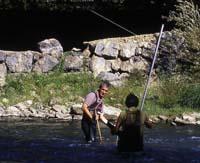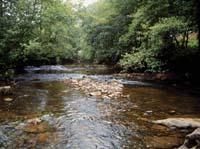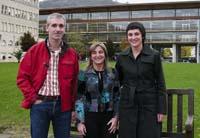Taking the pulse to the rivers
2007/01/01 Kortabitarte Egiguren, Irati - Elhuyar Zientzia Iturria: Elhuyar aldizkaria

Data processing
In addition to the information passed by the Provincial Council, they periodically address these rivers performing water analysis, sampling and other tests. All this data is then processed. To do this they have developed a computer system: Rivermet. Basically, they see how the oxygen concentration changes from day to night, in several curves represented on an Excel page. UPV-EHU researchers have managed to deal with and work with a large number of data relatively automatically, and it is not a simple task.
This developed computer system allows to visualize in a very integrated way the operation of all the rivers and to carry out an exhaustive monitoring of the same. They get the same information as about one inch.
But there is a small problem: determine the normal state of the river. At the moment this has been investigated little worldwide and it is not very clear when it can be said that the state of the river is normal and when it is violated. That is, critical levels are not somehow consolidated. There are very orientative values.
The computer tool developed by UPV/EHU researchers opens the doors to learn more about this aspect. In fact, it allows to analyze at all times the simultaneous operation of all rivers. Once you have a lot of data of this type, you will know more clearly what the critical level is. For example, the situation of the Deba River is worrying, but if we begin to improve, when can we know that it has gone from black to white? The tool will help solve these and other cases.

Respite
The results show that in the Basque Country rivers continue to have high levels of pollution. Yes they have improved, most have fish. However, significant variations in oxygen concentration in river metabolism have still been observed in some cases.
Now they want to know what are the factors that most influence metabolism. They know, among other things, that the shape, light and temperature of water courses influence. In fact, photosynthesis and respiratory processes do not occur in the same way in channeled and non-channeled rivers.
Whether or not the river has forests beside it. In rivers with few forests on their shores, the water is very hot in summer. Reduces the presence of oxygen and facilitates access to anoxia status (lack of oxygen). In fact, despite the high production of oxygen, the amount of oxygen consumed in photosynthesis is also high due to the large number of living beings. Therefore, especially at night, they are easily accessible to the state of anoxia. In the gloomy rivers, on the contrary, hardly light reaches the river, so there are usually no large productions.
Therefore, in addition to knowing what fish and how much is in the rivers, it is very interesting to know how the water breathes to study the ecosystem in its entirety.





